A CFD Study on Heat Transfer Performance of SiO2-TiO2 Nanofluids under Turbulent Flow
Abstract
:1. Introduction
2. Empirical Correlations and Fluid Properties
2.1. Theoretical Background
2.2. Forced Flow in Circular Tubes
2.2.1. Turbulent Flow
2.3. Fluid Properties
3. CFD Analysis
3.1. Arrangements of the Numerical Experiment
3.2. Grid Independence Test
3.3. Fully Developed Flow
3.4. Velocity and Temperature Profiles
3.5. Results
3.5.1. Constant HF with Non-Variable Properties, Developed Flow
3.5.2. Constant Wall Temperature with Non-Variable Properties and Developed Flow
- The Nu numbers of the constant wall temperature are 7–10% higher than the Nu numbers of the constant HF, and the difference increases as the Re number increases. The difference for constant HF and constant wall temperature is considered small in the literature, for example, in [23], but due to the greater temperature difference alongside the tube length, the HT is more intensive in the case of constant wall temperature. Moreover, the observed differences in the context of the accuracy of HT measurements are satisfactory;
- The DB correlation underestimates, while the ST correlation gives practically the same Nu numbers for constant HF;
- The ST correlation values are less than the numerical simulation result till Re = 14,000 and are above the simulation result only when Re = 17,000. It should also be mentioned that the ST correlation by [23] is valid only to Re = 10,000, but according to our results, it can be used at least to Re = 17,000;
- The correlation that contains the friction factor performs better at higher Re numbers. It should be mentioned that the application range for vonK starts from Re = 10,000, and for Gn, from Re = 2300, but vonK performs well below Re = 10,000 as well.
3.5.3. Constant HF with Variable Properties
3.5.4. Constant Wall Temperature with Variable Properties
3.5.5. HT in Flow Development
3.5.6. Friction Factors
4. Conclusions
- Most of the simplifications in the context of the turbulent flow are acceptable, but one has to refer to the borders of the simplifications;
- When the real conditions do not meet the simplified circumstances, one should refer to the complex phenomenon;
- In the case of moderate temperature differences, the constant properties give similar results to the temperature-dependent case with lower computational cost;
- The Nusselt number and pressure drop increase with increasing concentrations of hybrid nanofluids and flow rate, in agreement with many experimental and theoretical studies.
- Compared with previous research, the simulated results are acceptable.
Author Contributions
Funding
Conflicts of Interest
Nomenclature
| HN | Hybrid nanofluid |
| HT | Heat transfer |
| HF | Heat flux |
| CFD | Computer fluid dynamics |
| EG | Ethylene glycol |
| PD | Pressure drop |
| MWCNT | Multi wal carbon nanotubes |
| Re | Reynolds number |
| Nu | Nusselt number |
| Pr | Prandtl number |
References
- le Ba, T.; Mahian, O.; Wongwises, S.; Szilágyi, I.M. Review on the recent progress in the preparation and stability of graphene-based nanofluids. J. Therm. Anal. Calorim. 2020, 142, 1–28. [Google Scholar] [CrossRef] [Green Version]
- Xiong, Q.; Altnji, S.; Tayebi, T.; Izadi, M.; Hajjar, A.; Sundén, B.; Li, L.K.B. A comprehensive review on the application of hybrid nanofluids in solar energy collectors. Sustain. Energy Technol. Assess. 2021, 47, 101341. [Google Scholar] [CrossRef]
- Bianco, V.; Manca, O.; Nardini, S. Numerical investigation on nanofluids turbulent convection heat transfer inside a circular tube. Int. J. Therm. Sci. 2021, 50, 341–349. [Google Scholar] [CrossRef]
- Wang, J.; Zhu, J.; Zhang, X.; Chen, Y. Heat transfer and pressure drop of nanofluids containing carbon nanotubes in laminar flows. Exp. Therm. Fluid Sci. 2013, 44, 716–721. [Google Scholar] [CrossRef]
- Hussein, A.M.; Sharma, K.V.; Bakar, R.A.; Kadirgama, K. The effect of cross sectional area of tube on friction factor and heat transfer nanofluid turbulent flow. Int. Commun. Heat Mass Transf. 2013, 47, 49–55. [Google Scholar] [CrossRef]
- Hussein, A.M.; Bakar, R.A.; Kadirgama, K. Study of forced convection nanofluid heat transfer in the automotive cooling system. Case Stud. Therm. Eng. 2014, 2, 50–61. [Google Scholar] [CrossRef] [Green Version]
- Kumar, A.; Sharma, K.; Dixit, A.R. A review of the mechanical and thermal properties of graphene and its hybrid polymer nanocomposites for structural applications. J. Mater. Sci. 2018, 54, 5992–6026. [Google Scholar] [CrossRef]
- Kumar, A.; Sharma, K.; Dixit, A.R. Carbon nanotube- and graphene-reinforced multiphase polymeric composites: Review on their properties and applications. J. Mater. Sci. 2019, 55, 2682–2724. [Google Scholar] [CrossRef]
- Pak, B.C.; Cho, Y.I. Hydrodynamic and heat transfer study of dispersed fluids with submicron metallic oxide particles. Exp. Heat Transf. 1998, 11, 151–170. [Google Scholar] [CrossRef]
- Sharma, K.V.; Sundar, L.S.; Sarma, P.K. Estimation of heat transfer coefficient and friction factor in the transition flow with low volume concentration of Al2O3 nanofluid flowing in a circular tube and with twisted tape insert. Int. Commun. Heat Mass Transf. 2009, 36, 503–507. [Google Scholar] [CrossRef]
- Kim, J.-O.; Jung, J.-P.; Lee, J.-H.; Suh, J.; Kang, H.-S. Effects of laser parameters on the characteristics of a Sn-3.5 wt.%Ag solder joint. Met. Mater. Int. 2009, 15, 119–123. [Google Scholar] [CrossRef]
- le Ba, T.; Alkurdi, A.Q.; Lukács, I.E.; Molnár, J.; Wongwises, S.; Gróf, G.; Szilágyi, I.M. A Novel Experimental Study on the Rheological Properties and Thermal Conductivity of Halloysite Nanofluids. Nanomaterials 2020, 10, 1834. [Google Scholar] [CrossRef] [PubMed]
- Eshgarf, H.; Kalbasi, R.; Maleki, A.; Shadloo, M.S.; Karimipour, A. A review on the properties, preparation, models and stability of hybrid nanofluids to optimize energy consumption. J. Therm. Anal. Calorim. 2021, 144, 1959–1983. [Google Scholar] [CrossRef]
- Ghalandari, M.; Maleki, A.; Haghighi, A.; Shadloo, M.S.; Nazari, M.A.; Tlili, I. Applications of nanofluids containing carbon nanotubes in solar energy systems: A review. J. Mol. Liq. 2020, 313, 113476. [Google Scholar] [CrossRef]
- Suresh, S.; Venkitaraj, K.P.; Selvakumar, P.; Chandrasekar, M. Synthesis of Al2O3-Cu/water hybrid nanofluids using two step method and its thermo physical properties, Colloids Surfaces A Physicochem. Eng. Asp. 2011, 388, 41–48. [Google Scholar] [CrossRef]
- Madhesh, D.; Kalaiselvam, S. Experimental Analysis of Hybrid Nanofluid as a Coolant; Elsevier Ltd.: Amsterdam, The Netherlands, 2014; pp. 1667–1675. [Google Scholar] [CrossRef] [Green Version]
- Suresh, S.; Venkitaraj, K.P.; Selvakumar, P.; Chandrasekar, M. Effect of Al 2O 3-Cu/water hybrid nanofluid in heat transfer. Exp. Therm. Fluid Sci. 2012, 38, 54–60. [Google Scholar] [CrossRef]
- Mosayebidorcheh, S.; Sheikholeslami, M.; Hatami, M.; Ganji, D.D. Analysis of turbulent MHD Couette nanofluid flow and heat transfer using hybrid DTM-FDM. Particuology 2016, 26, 95–101. [Google Scholar] [CrossRef]
- Abbasi, S.M.; Rashidi, A.; Nemati, A.; Arzani, K. The effect of functionalisation method on the stability and the thermal conductivity of nanofluid hybrids of carbon nanotubes/gamma alumina. Ceram. Int. 2013, 39, 3885–3891. [Google Scholar] [CrossRef]
- Labib, M.N.; Nine, M.J.; Afrianto, H.; Chung, H.; Jeong, H. Numerical investigation on effect of base fluids and hybrid nanofluid in forced convective heat transfer. Int. J. Therm. Sci. 2013, 71, 163–171. [Google Scholar] [CrossRef]
- Sundar, L.S.; Singh, M.K.; Sousa, A.C.M. Enhanced heat transfer and friction factor of MWCNT-Fe3O4/water hybrid nanofluids. Int. Commun. Heat Mass Transf. 2014, 52, 73–83. [Google Scholar] [CrossRef]
- Baby, T.T.; Sundara, R. Surfactant free magnetic nanofluids based on core-shell type nanoparticle decorated multiwalled carbon nanotubes. J. Appl. Phys. 2011, 110, 064325. [Google Scholar] [CrossRef]
- Rohsenow, W.M.; Hartnett, J.R.; Cho, Y.I. Handbook of Heat Transfer; McGraw-Hill: New York, NY, USA, 1998. [Google Scholar]
- le Ba, T.; Várady, Z.I.; Lukács, I.E.; Molnár, J.; Balczár, I.A.; Wongwises, S.; Szilágyi, I.M. Experimental investigation of rheological properties and thermal conductivity of SiO2–P25 TiO2 hybrid nanofluids. J. Therm. Anal. Calorim. 2020, 146, 1–15. [Google Scholar] [CrossRef]
- Mishra, S.K.; Chandra, H.; Arora, A. Effect of velocity and rheology of nanofluid on heat transfer of laminar vibrational flow through a pipe under constant heat flux. Int. Nano Lett. 2019, 9, 245–256. [Google Scholar] [CrossRef] [Green Version]
- Saedodin, S.; Zaboli, M.; Ajarostaghi, S.S.M. Hydrothermal analysis of heat transfer and thermal performance characteristics in a parabolic trough solar collector with Turbulence-Inducing elements. Sustain. Energy Technol. Assess. 2021, 46, 101266. [Google Scholar] [CrossRef]
- Entrance Length, Aerospace, Mech. Mechatron. Engg. 2005. Available online: http://www-mdp.eng.cam.ac.uk/web/library/enginfo/aerothermal_dvd_only/aero/fprops/pipeflow/node9.html (accessed on 7 June 2021).
- Zhi-qing, W. Study on correction coefficients of liminar and turbulent entrance region effect in round pipe. Appl. Math. Mech. 1982, 3, 433–446. [Google Scholar] [CrossRef]
- Cengel, Y.A. Heat Transfer. A Practical Approach, 2nd ed.; McGraw-Hill: New York, NY, USA, 2002. [Google Scholar]


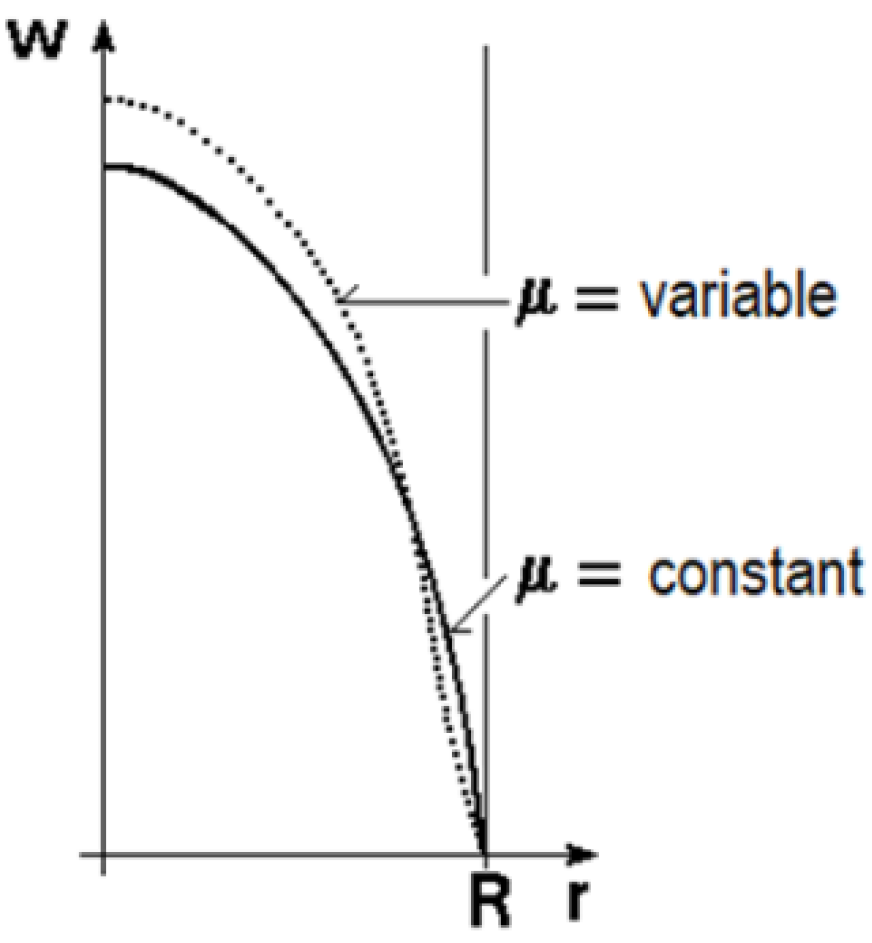

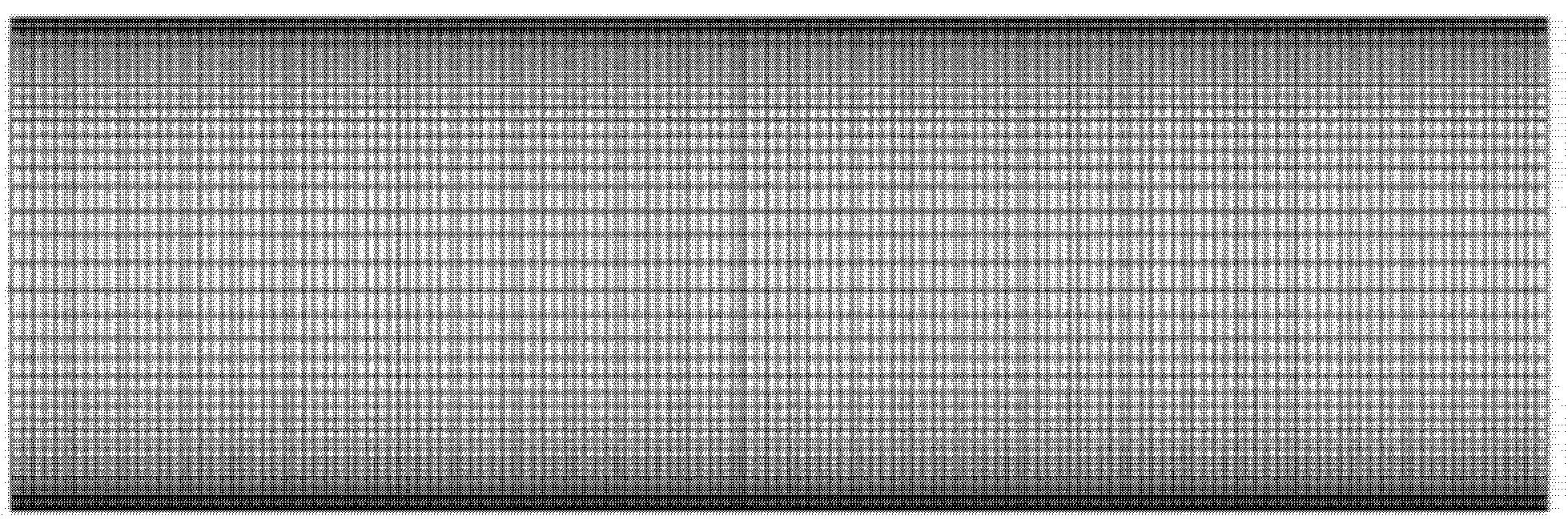
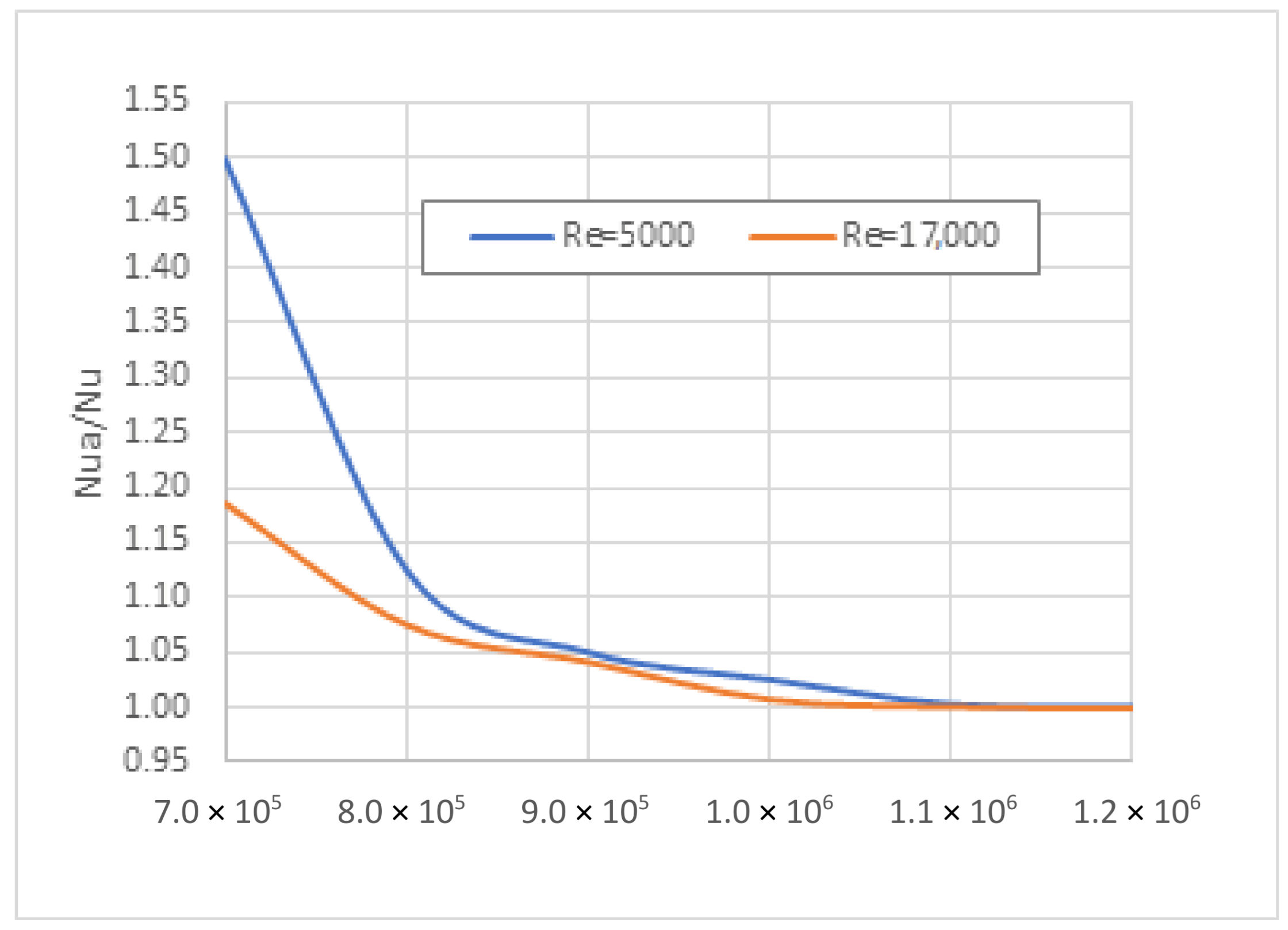
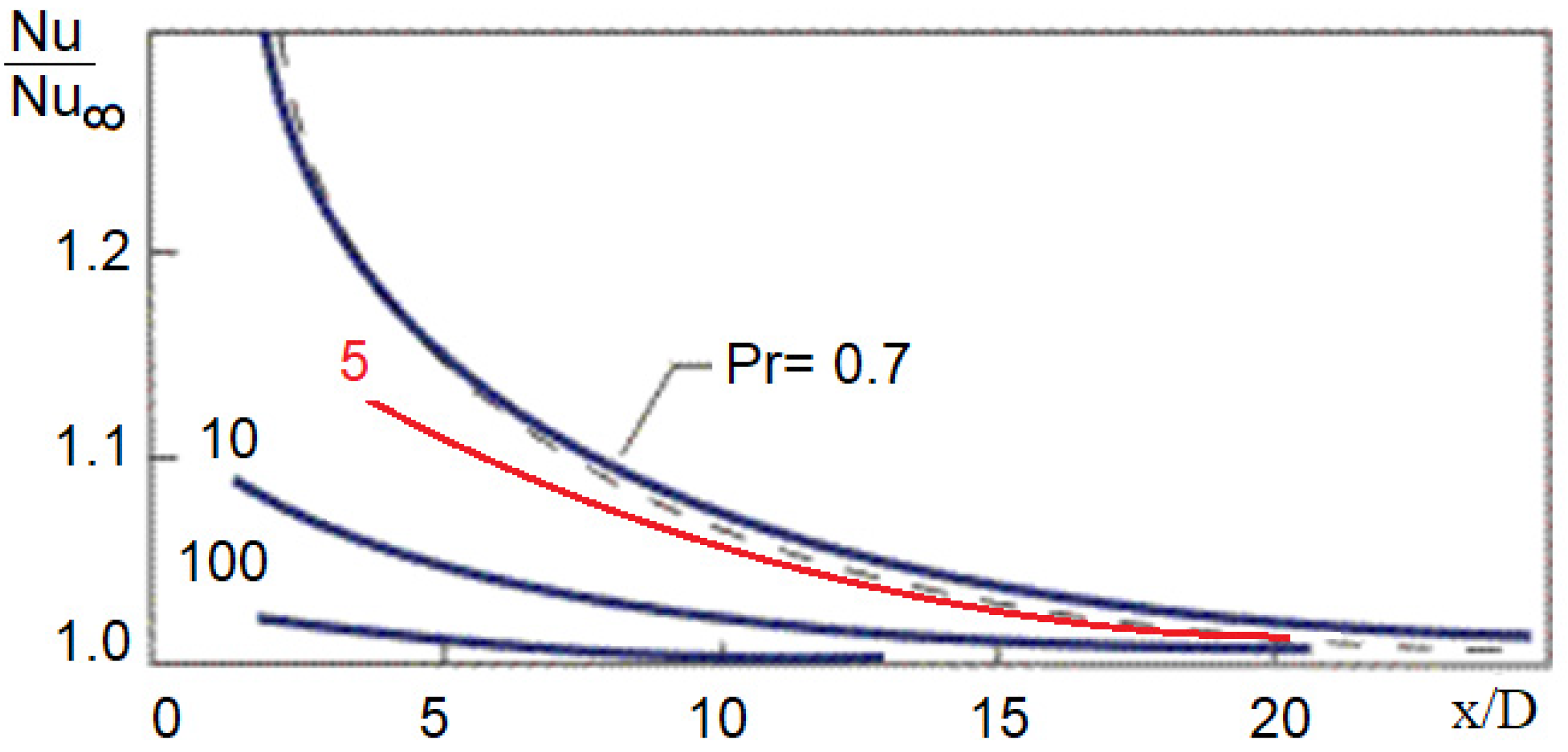
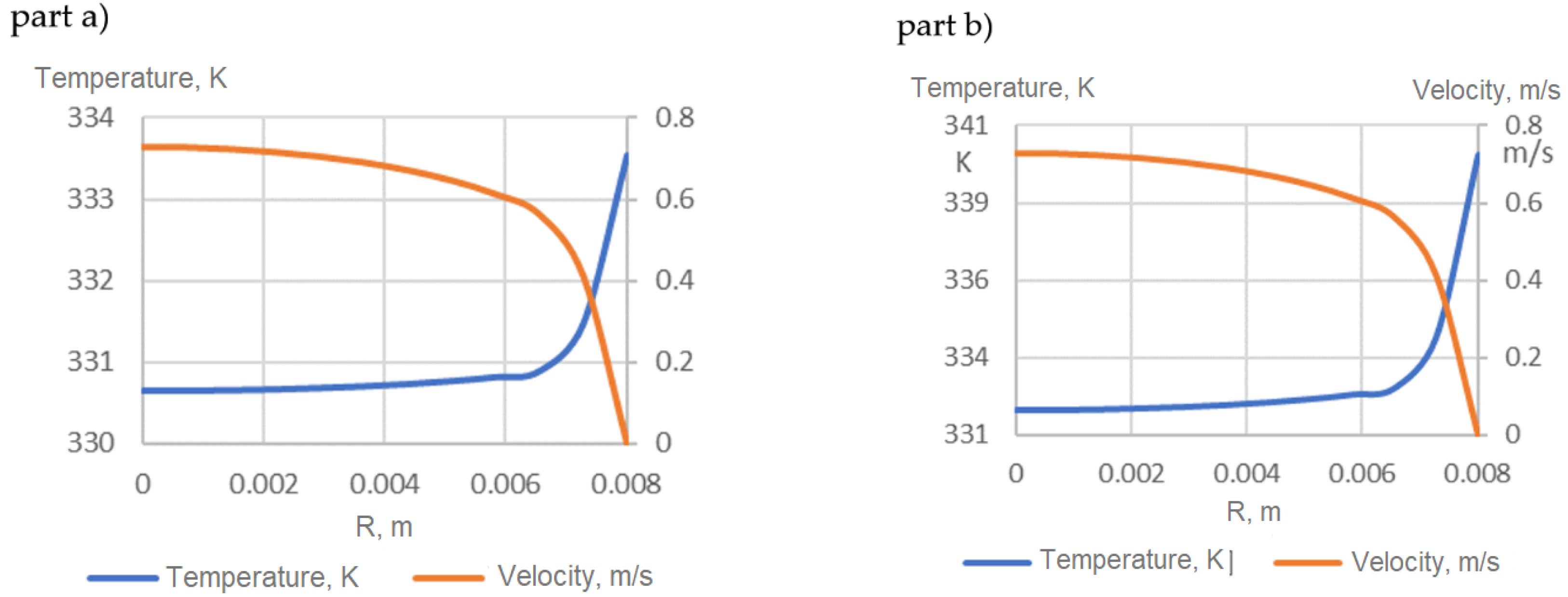
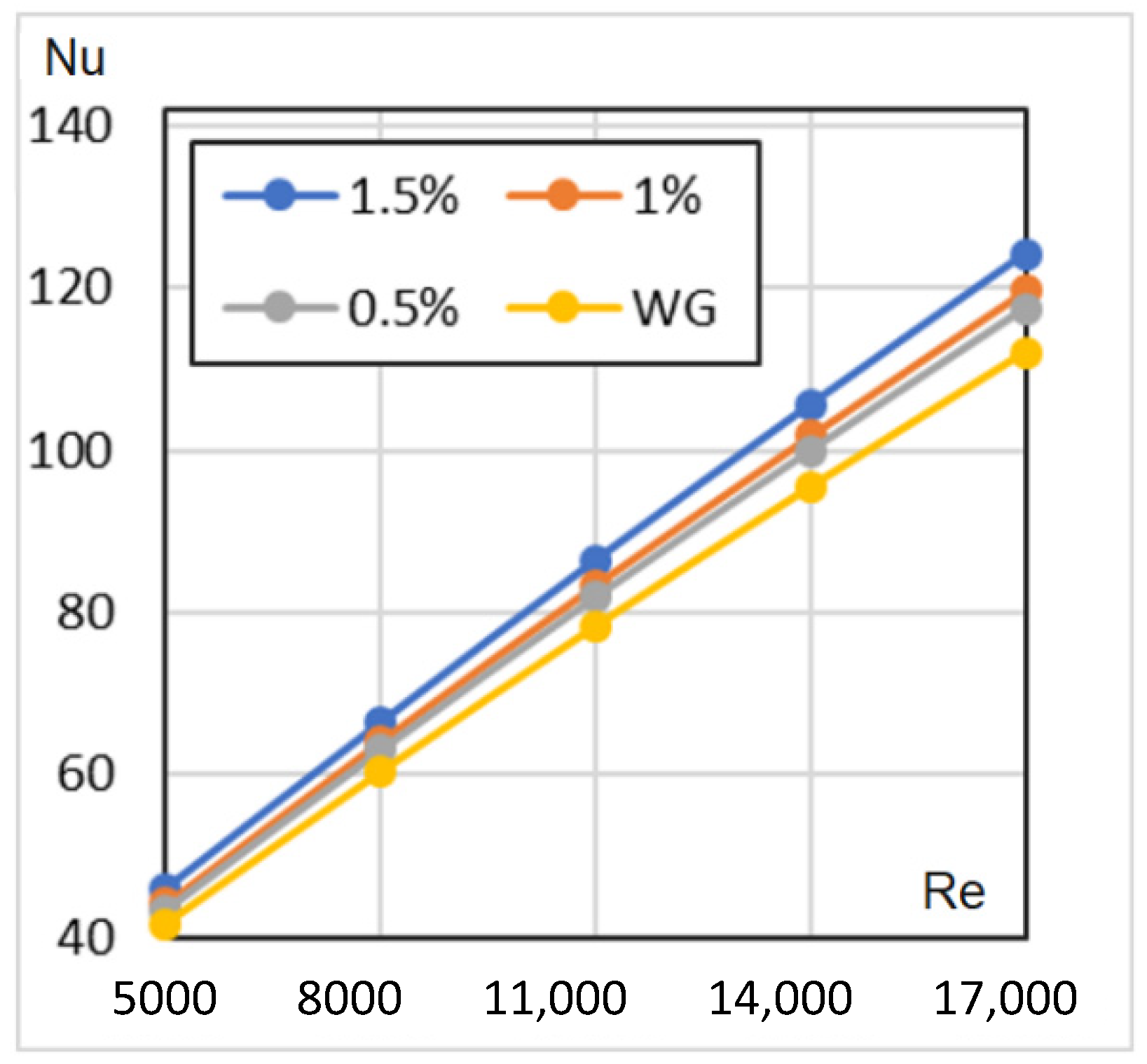
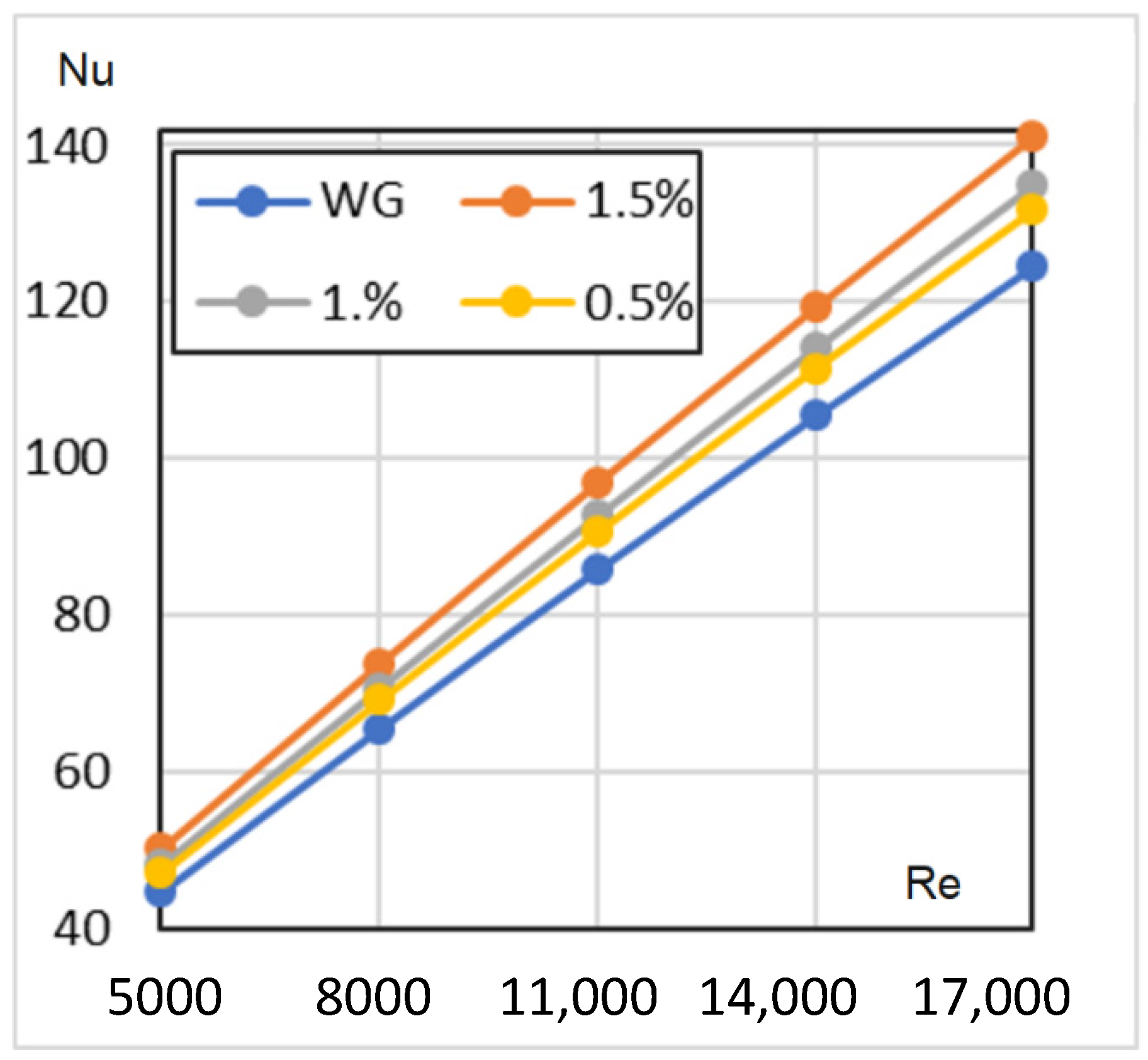
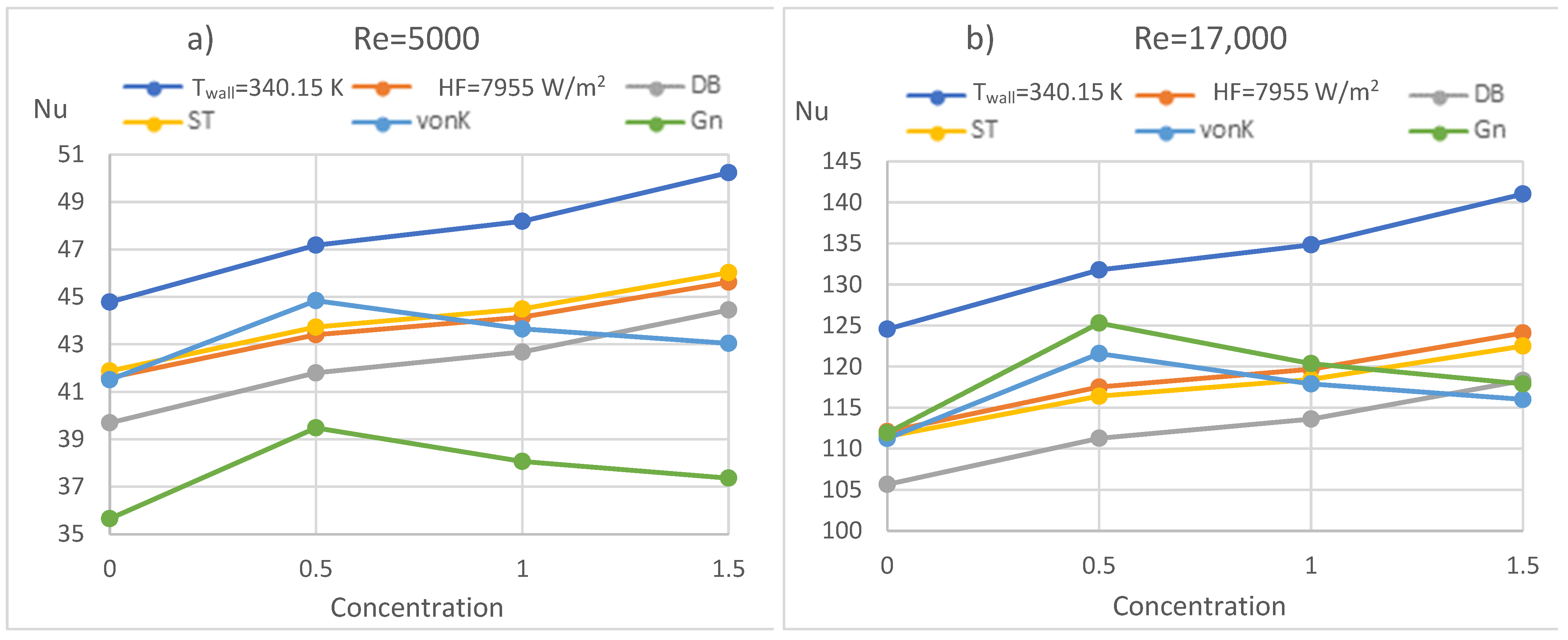
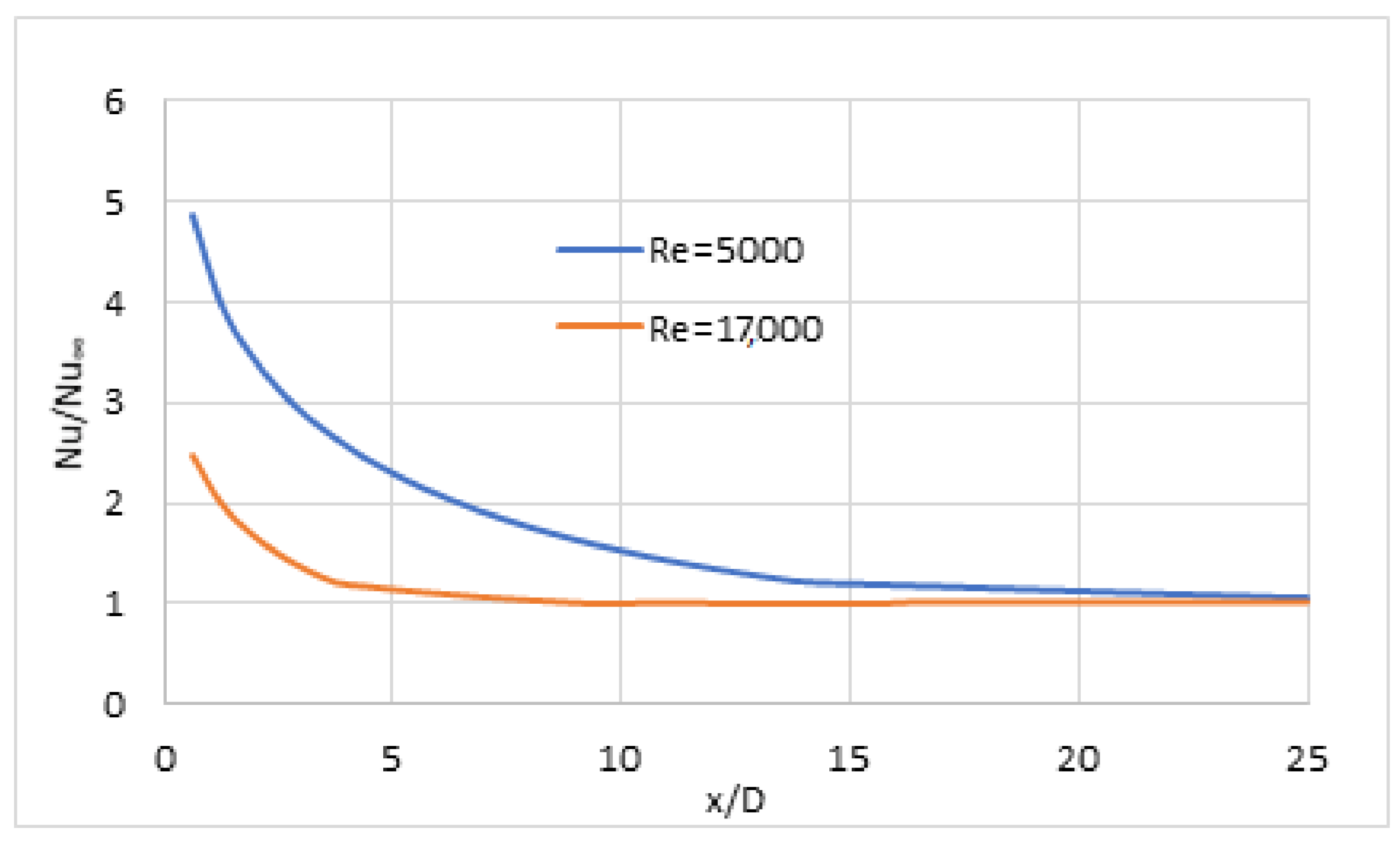
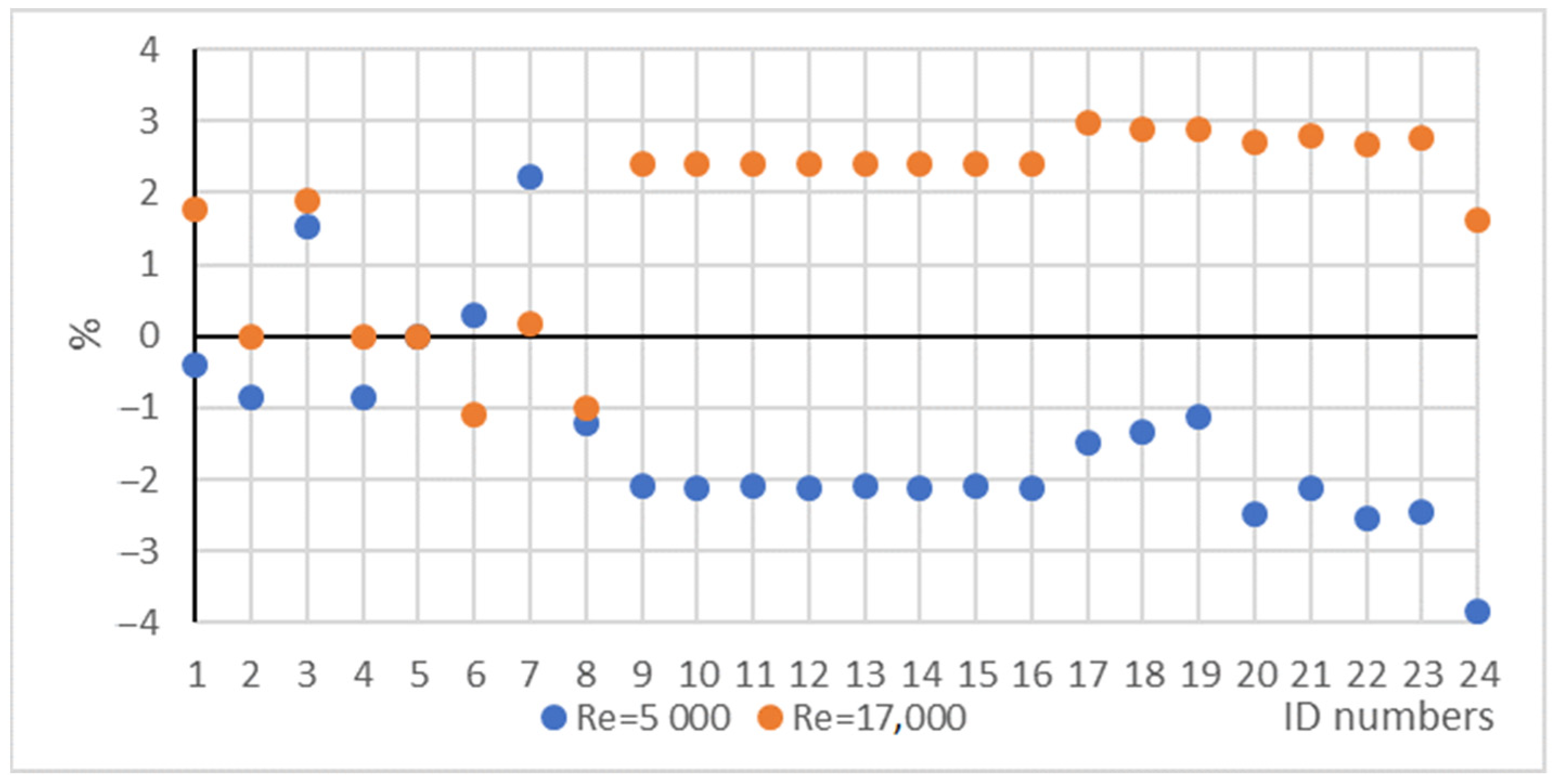
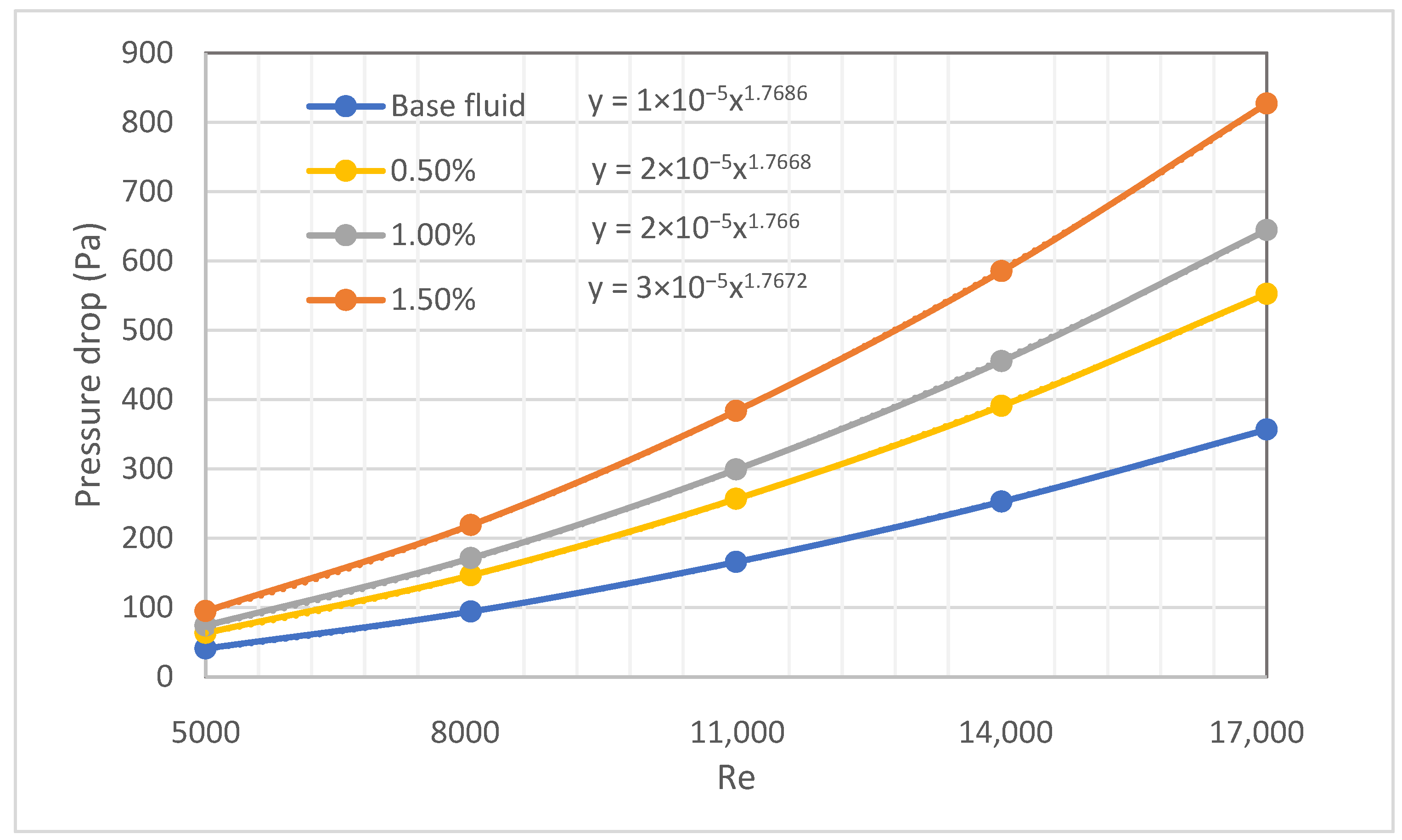
| Correlations (a) | Application Range |
|---|---|
| Dittus–Boelter (1) | |
| Colburn (2) | |
| Drexel–McAdams (3) | |
| Gnielinski (4,5) | |
| Sieder–Tate (6) | |
| Hausen (7) |
| Correlations (a) | Application Range |
|---|---|
| von Kármán (8) | 0.7 ≤ Pr ≤ 10 104 ≤ Re ≤ 5 × 106 |
| Prandtl (9) | 0.5 ≤ Pr ≤ 5 104 ≤ Re ≤ 5 × 106 |
| Friend–Metzner (10) | 50 ≤ Pr ≤ 600 5·104 ≤ Re ≤ 5 × 106 |
| Pethukov–Kirillov–Popov (11) | 0.5 ≤ Pr ≤ 106 4000 ≤ Re ≤ 5 × 106 |
| Webb (12) | 0.5 ≤ Pr ≤ 100 104 ≤ Re ≤ 5 × 106 |
| Gnielinski (13) | 0.5 ≤ Pr ≤ 2000 2300 ≤ Re ≤ 5 × 106 For the case of constant fluid properties: D/L = 0, and ΦT = 1. |
| Sandall et al. (14) | 0.5 ≤ Pr ≤ 2000 104 ≤ Re ≤ 5 × 106 |
| Correlations | Application Range |
|---|---|
| Blasius | 4 × 103 ≤ Re ≤ 105 |
| Drew et al. | 4 × 103 ≤ Re ≤ 5 × 106 4 × 103 ≤ Re ≤ 107 |
| Bhatti and Shah | 4 × 103 ≤ Re ≤ 107 |
| Prandtl–Kármán–Nikuradse | 4 × 103 ≤ Re ≤ 107 |
| Colebrook | 4 × 103 ≤ Re ≤ 107 |
| Filonenko | 104 ≤ Re ≤ 107 |
| Techo et al. | 104 ≤ Re ≤ 107 |
| Temperature °C | Ρ g/cm3 | k W/mK | µ [mPas] | cp J/gK |
|---|---|---|---|---|
| 0.50 vol% SiO2-P25 | ||||
| 20 | 1.033 | 0.510 | 1.789 | 3848.04 |
| 30 | 1.030 | 0.535 | 1.470 | 3863.36 |
| 40 | 1.026 | 0.549 | 1.152 | 3887.89 |
| 50 | 1.022 | 0.561 | 0.978 | 3903.14 |
| 60 | 1.017 | 0.568 | 0.815 | 3925.54 |
| 1.00 vol% SiO2-P25 | ||||
| 20 | 1.044 | 0.522 | 2.054 | 3799.25 |
| 30 | 1.041 | 0.546 | 1.594 | 3814.19 |
| 40 | 1.037 | 0.56 | 1.313 | 3838.14 |
| 50 | 1.033 | 0.571 | 1.079 | 3852.96 |
| 60 | 1.028 | 0.578 | 0.885 | 3874.74 |
| 1.50 vol% SiO2-P25 | ||||
| 20 | 1.055 | 0.531 | 2.281 | 3733.92 |
| 30 | 1.052 | 0.553 | 1.825 | 3766.05 |
| 40 | 1.048 | 0.568 | 1.445 | 3789.45 |
| 50 | 1.045 | 0.579 | 1.212 | 3803.85 |
| 60 | 1.039 | 0.587 | 1.008 | 3825.04 |
| Concentrations | ||||
|---|---|---|---|---|
| 0.50% | 1% | 1.50% | ||
| Pr Numbers | ||||
| Temperature, °C | 20 | 13.50 | 14.95 | 16.04 |
| 30 | 10.62 | 11.14 | 12.43 | |
| 40 | 8.16 | 9.00 | 9.64 | |
| 50 | 6.80 | 7.28 | 7.96 | |
| 60 | 5.63 | 5.93 | 6.57 | |
| 70 | 5.05 | 5.57 | 6.00 | |
| 80 | 4.37 | 4.83 | 5.20 | |
| 90 | 3.86 | 4.26 | 4.59 | |
| 100 | 3.45 | 3.80 | 4.10 | |
| Re | Le/D, [27] | Le, m [29] | Le/D, [28] |
|---|---|---|---|
| 5000 | 18.2 | 0.29 | 11.4 |
| 8000 | 19.7 | 0.31 | 12.9 |
| 11,000 | 20.8 | 0.33 | 13.9 |
| 14,000 | 21.6 | 0.35 | 14.8 |
| 17,000 | 22.3 | 0.36 | 15.5 |
| 0.5% | 1.0% | 1.5% | ||||
|---|---|---|---|---|---|---|
| Re | Const. | Variable | Const. | Variable | Const. | Variable |
| 5000 | 43.4 | 43.7 | 44.1 | 44.5 | 45.6 | 45.5 |
| 8000 | 63.1 | 64.2 | 64.2 | 65.3 | 66.4 | 66.9 |
| 11,000 | 81.9 | 83.3 | 83.4 | 84.8 | 86.4 | 86.9 |
| 14,000 | 100.0 | 101.5 | 101.8 | 103.4 | 105.5 | 105.9 |
| 17,000 | 117.5 | 119.0 | 119.7 | 121.2 | 124.1 | 124.2 |
| 0.5% | 1.0% | 1.5% | ||||
|---|---|---|---|---|---|---|
| Re | Const. | Variable | Const. | Variable | Const. | Variable |
| 5000 | 47.2 | 47.2 | 48.2 | 48.6 | 50.2 | 50.0 |
| 8000 | 69.2 | 70.1 | 70.7 | 72.6 | 73.8 | 74.8 |
| 11,000 | 90.7 | 91.6 | 92.7 | 95.2 | 96.9 | 98.3 |
| 14,000 | 111.6 | 112.1 | 114.1 | 117.0 | 119.3 | 120.8 |
| 17,000 | 131.8 | 132.0 | 134.8 | 138.1 | 141.0 | 142.7 |
| Case Identification | No. | Friction Factors | ||
|---|---|---|---|---|
| Re = 5000 | Re = 17,000 | |||
| Numbers of Table 3 correlations | 1 | 1 | 0.037626513 | 0.027709216 |
| 2 | 2 | 0.037458997 | 0.027222256 | |
| 3 | 3 | 0.038356659 | 0.027742485 | |
| 4 | 4 | 0.037458997 | 0.027222256 | |
| 5 | 5 | 0.037777816 | 0.027226969 | |
| 6 | 6 | 0.037893426 | 0.026929325 | |
| 7 | 7 | 0.038619473 | 0.027272146 | |
| 8 | 8 | 0.037320168 | 0.026953634 | |
| Constant HF non-variable properties | 0% | 9 | 0.036984055 | 0.027878525 |
| 0.5% | 10 | 0.036983276 | 0.027878481 | |
| 1% | 11 | 0.036983498 | 0.02787853 | |
| 1.5% | 12 | 0.036983328 | 0.027878432 | |
| Constant wall temperature non-variable properties | 0% | 13 | 0.036984055 | 0.027878525 |
| 0.5% | 14 | 0.036983276 | 0.027878481 | |
| 1% | 15 | 0.036983498 | 0.02787853 | |
| 1.5% | 16 | 0.036983328 | 0.027878432 | |
| Constant HF variable properties | 0% | 17 | 0.037219022 | 0.028036842 |
| 0.5% | 18 | 0.03727405 | 0.028011376 | |
| 1% | 19 | 0.037350228 | 0.028012885 | |
| 1.5% | 20 | 0.036843771 | 0.02796081 | |
| Constant wall temperature variable properties | 0% | 21 | 0.036975466 | 0.027986751 |
| 0.5% | 22 | 0.036819132 | 0.027951593 | |
| 1% | 23 | 0.036852728 | 0.027979754 | |
| 1.5% | 24 | 0.036324745 | 0.027667343 | |
Publisher’s Note: MDPI stays neutral with regard to jurisdictional claims in published maps and institutional affiliations. |
© 2022 by the authors. Licensee MDPI, Basel, Switzerland. This article is an open access article distributed under the terms and conditions of the Creative Commons Attribution (CC BY) license (https://creativecommons.org/licenses/by/4.0/).
Share and Cite
Ba, T.L.; Gróf, G.; Odhiambo, V.O.; Wongwises, S.; Szilágyi, I.M. A CFD Study on Heat Transfer Performance of SiO2-TiO2 Nanofluids under Turbulent Flow. Nanomaterials 2022, 12, 299. https://doi.org/10.3390/nano12030299
Ba TL, Gróf G, Odhiambo VO, Wongwises S, Szilágyi IM. A CFD Study on Heat Transfer Performance of SiO2-TiO2 Nanofluids under Turbulent Flow. Nanomaterials. 2022; 12(3):299. https://doi.org/10.3390/nano12030299
Chicago/Turabian StyleBa, Thong Le, Gyula Gróf, Vincent Otieno Odhiambo, Somchai Wongwises, and Imre Miklós Szilágyi. 2022. "A CFD Study on Heat Transfer Performance of SiO2-TiO2 Nanofluids under Turbulent Flow" Nanomaterials 12, no. 3: 299. https://doi.org/10.3390/nano12030299
APA StyleBa, T. L., Gróf, G., Odhiambo, V. O., Wongwises, S., & Szilágyi, I. M. (2022). A CFD Study on Heat Transfer Performance of SiO2-TiO2 Nanofluids under Turbulent Flow. Nanomaterials, 12(3), 299. https://doi.org/10.3390/nano12030299








